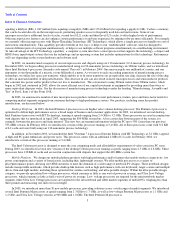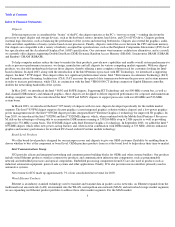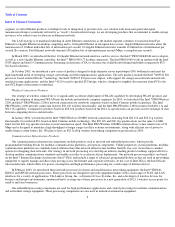Intel 2003 Annual Report Download - page 14
Download and view the complete annual report
Please find page 14 of the 2003 Intel annual report below. You can navigate through the pages in the report by either clicking on the pages listed below, or by using the keyword search tool below to find specific information within the annual report.
Table of Contents
Index to Financial Statements
Purchases by customers often allow them to participate in cooperative advertising and marketing programs such as the Intel Inside
Program. Through the Intel Inside Program, OEMs are licensed to place the Intel Inside logos on computers with our microprocessors and our
other technology and use the brands in advertisements. The program includes a market development component that accrues funds based on
purchases and partially reimburses the OEMs for advertisements for products featuring the Intel Inside brand. This program broadens brand
reach beyond the scope of our direct advertising.
Additionally, our reseller sales channel marketing programs are intended to extend the Intel Inside brand reach to channel customers and
the businesses and individuals that purchase computer systems from them. In 2003, we initiated a program to extend the awareness of our
brand outside of the OEM and system integrator community. As part of the Intel Centrino mobile technology launch, new co-marketing
programs were initiated with wireless service providers and at public wireless access point locations. New co-marketing activities with
independent system vendors are also under way.
Our products are typically shipped under terms that transfer title to the customer, even in arrangements for which the customer may have
a right to return or to exchange the products and the recognition of revenue on the sale is deferred. The sales agreements typically provide that
payment is due at a later date, such as 30 days after shipment, delivery or the customer’s use of the product. Our credit department sets
accounts receivable and shipping limits for individual customers, for the purpose of controlling credit risk to Intel arising from outstanding
account balances. We assess credit risk through quantitative and qualitative analysis, and from this analysis, we establish credit limits and
determine whether we will seek to use one or more credit support devices, such as obtaining some form of third-
party guaranty or standby letter
of credit, or obtaining credit insurance for all or a portion of the account balance. Credit losses may still be incurred due to bankruptcy, fraud or
other failure of the customer to pay. See “Schedule II—Valuation and Qualifying Accounts” on page 90 of this Form 10-K for information
about our allowance for doubtful receivables.
Backlog
We do not believe that a backlog as of any particular date is indicative of future results. Our sales are made primarily pursuant to standard
purchase orders for delivery of standard products. We have some agreements that give a customer the right to purchase a specific number of
products during a specified time period. Although these agreements do not generally obligate the customer to purchase any particular number
of such products, some of these agreements do contain billback clauses. Under these clauses, customers who do not purchase the full volume
agreed upon are liable for billback on previous shipments up to the price appropriate for the quantity actually purchased. As a matter of
industry practice, billback clauses are difficult to enforce. The quantity actually purchased by the customer, as well as the shipment schedules,
are frequently revised during the agreement term to reflect changes in the customer’
s needs. In light of industry practice and our experience, we
do not believe that such agreements are meaningful for determining backlog amounts. We believe that only a small portion of our order
backlog is non-cancelable and that the dollar amount associated with the non-cancelable portion is not significant.
Competition
As part of our overall strategy to compete in each relevant market segment, we use our core competencies in the design and manufacture
of integrated circuits and financial resources, as well as our global presence and brand recognition. Also, under our Intel Capital program we
make equity investments in companies around the world to further our strategic objectives and support our key business initiatives. Our
products compete, to various degrees, on the basis of performance, quality, features that enhance user experience, brand recognition, price and
availability. Our ability to compete also depends upon our ability to provide worldwide support for our customers. Rapid technological
advances characterize the computing and communications industries, and our ability to compete depends on our ability to improve our products
and processes faster than our competitors, anticipate changing customer requirements, and develop and launch new products to meet changing
requirements, while reducing our costs at the same time. Our products compete with products developed for similar or rival architectures and
with products based on the same or rival technology standards. Our competitors also routinely add features to their products, seek to increase
the performance of their products and/or sell their products at lower prices over time. We cannot predict whether our products will continue to
compete successfully with existing rival architectures and/or whether new architectures will establish or gain broad acceptance or increase
competition with our products. We also cannot predict which competing technology standards will become the prevailing standards in the
market segments in which we compete.
In the semiconductor industry, as unit volumes grow, production experience is accumulated and costs decrease, further competition
develops, and as a result, prices decline rapidly. The life cycle of our products is very short, sometimes less than a year. Many companies
compete with us in the various computing, networking and communications market segments, and are engaged in the same basic fields of
activity, including research and development. Worldwide, these competitors range in size from large established
11
























